All About Alaska Fly Fishing: Advice From Guides And Lodges
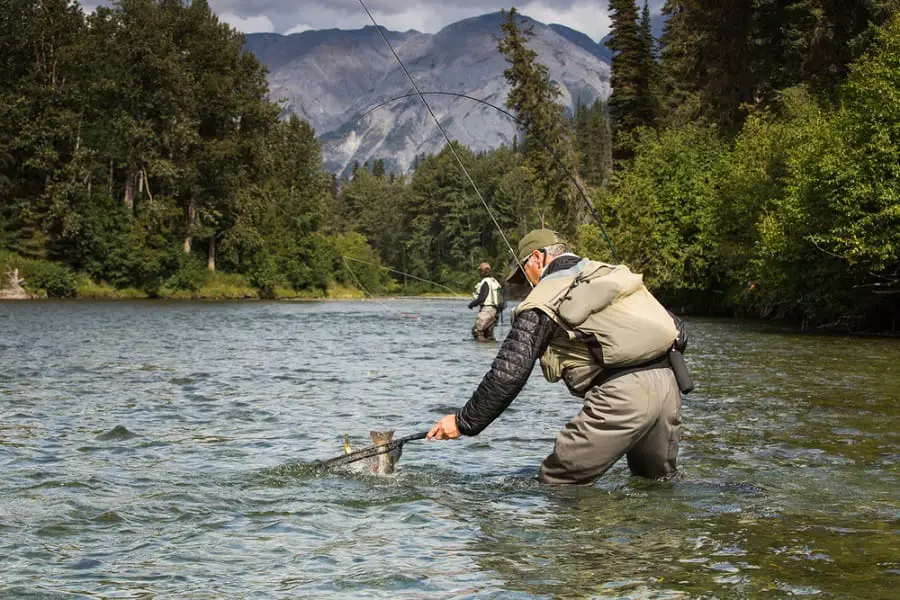
Alaska fly fishing is world-renowned and is very hard to beat with so many fish species, which include trout, steelhead, char, and five salmon species. Anglers can choose from many great rivers and streams, as well as some lakes or on the ocean, which all provide great fly fishing opportunities.
Often, there are too many options for fly fishing in Alaska that anglers don’t know where to start.
If you are planning on fly fishing in Alaska, consider these things:
- Time Of Year: Alaska’s weather can be brutal at times, so it’s essential to determine when the best fishing is for the species you want to target.
- Type of River: I prefer small to mid-sized rivers that look more like trout streams, and Alaska has plenty of these. But Alaska also has huge, fast rivers.
- Target Species: Although many rivers have fish in them year-round, if you have a specific species you want to target, there are prime times when they will be in the river in good numbers.
- Safety: Some rivers can be very fast and deep and can be dangerous. There are also grizzly bears in the area. You may want to consider hiring a guide for protection and safety.
- Cost: The cost of your trip will depend on prime time, availability, where you travel from, whether you use a guide or need a boat, or whether you try to do it yourself to cut costs. All are available options.
- Accommodations: you can choose from basic accommodations and food to luxury lodges.
- Travel: You should consider the distance you may need to travel in order to get to the rivers. In some areas, 4×4 vehicles or boats are required. Other areas you can easily drive to.
About Alaska Fly Fishing
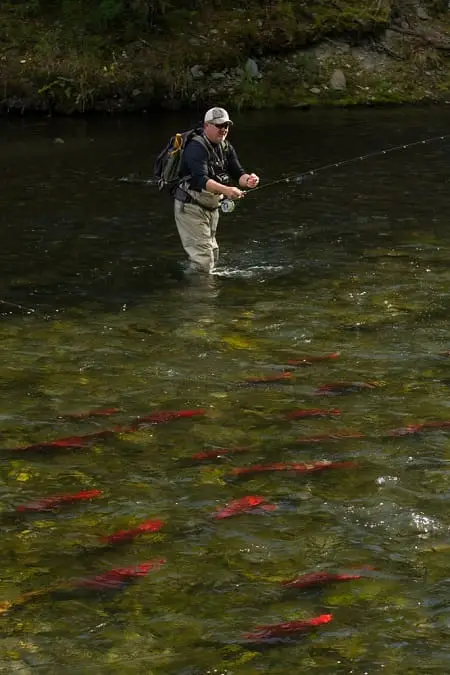
People come from around the globe to try fly fishing in Alaska’s wild rivers. The scenery is fantastic, and there are plenty of options for fly fishing.
You can target saltwater and freshwater fish, including all five Pacific salmon species – Kings, Silvers, Sockeye, Chum, and Pinks.
You also have the option to fish for steelhead, resident river rainbow trout, halibut, char, dolly varden, grayling, and pike.
Many anglers who fish in Alaska are surprised about how easy tossing flies for salmon or trout is. If you are worried about the technique of fly fishing, a good guide will solve that problem.
When Is Fly Fishing In Alaska Best
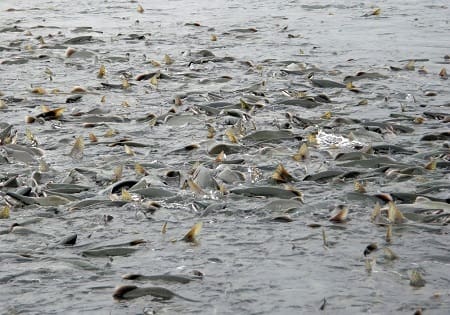
You may have seen pictures of salmon so thick that you could walk across them. They are likely images from Alaska, but this is not the norm.
There are times when fishing for salmon, steelhead, rainbows, and char is best, and if you can plan your trip during these times, the fishing can be fantastic.
Make no mistake, you can fish Alaska all year long if you can tolerate the colder weather, but the best time for salmon fishing trips is from May through September when the weather is warmer and the rivers are full of fish.
Kings and Rainbows
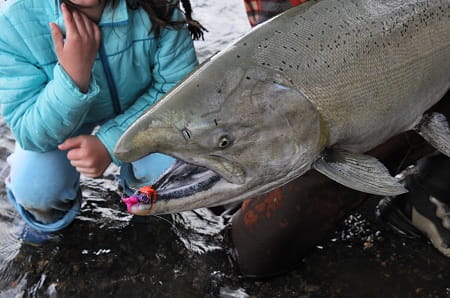
River fishing for king salmon is best between May and the first part of June.
May is also a good month to target kings at the mouth of rivers in the saltwater estuaries before they enter the river. Opt for a charter boat or guide, or you can fish from the shore.
The season for King Salmon closes early, and they are one of the first salmon species to make their way from the sea to their spawning grounds.
Even if the King salmon season closes, you still have the opportunity to target big rainbow trout with flies. The rainbows follow the king salmon to feed off their roe.
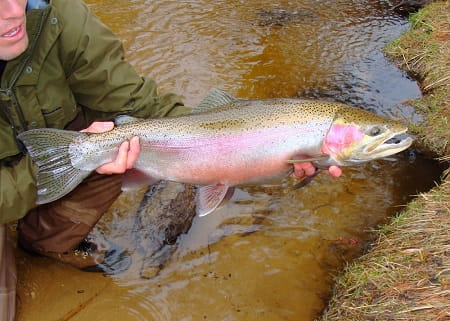
Rainbow trout will often stack up behind salmon and feed on eggs that get washed down the river.
These rainbows are resident river rainbows and can take on some very impressive reddish colors.
An Alaska fly fishing trip should include some trophy rainbow trout fishing since these rainbows can get huge.
A 20-30-inch rainbow is not uncommon on rainbow trout streams like the Kenai River, Russian River, Copper River, etc. Some will reach sizes over 8 pounds.
Chum, Pinks, and Sockeye
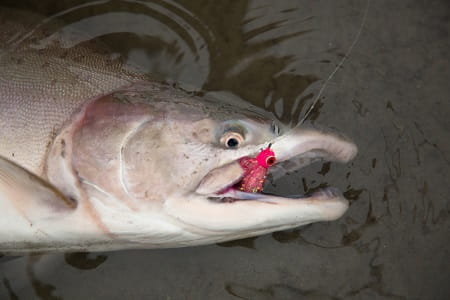
June and July are prime months for Chum Salmon and Sockeye Salmon in freshwater rivers.
If you are staying at a fishing lodge, they will be able to tell you the best time to visit, especially if you want to target specific fish.
The seasons and run times vary from one location to another throughout Alaska.
Silver Salmon and Char
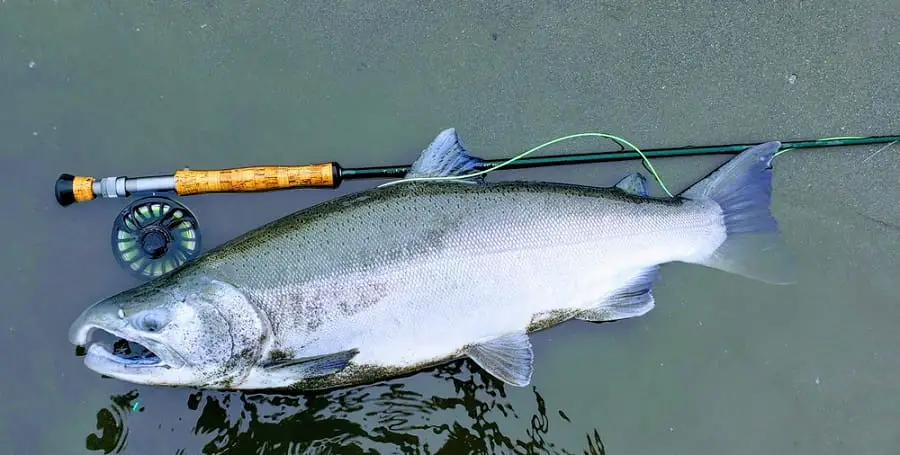
August and September are prime months for fly fishing for Silver Salmon, which are also known to many as Coho salmon, and for Char and Dolly Varden.
This time is best, especially along the Kenai peninsula.
During the Silver Salmon runs, you can also target Dolly Varden Char, which can easily hit the 25″ mark.
Fly fishing for salmon is a very effective way to catch them once they enter the rivers. Click HERE for the fly fishing tips and tactics used by salmon guides.
Fly Fishing Alaska Steelhead
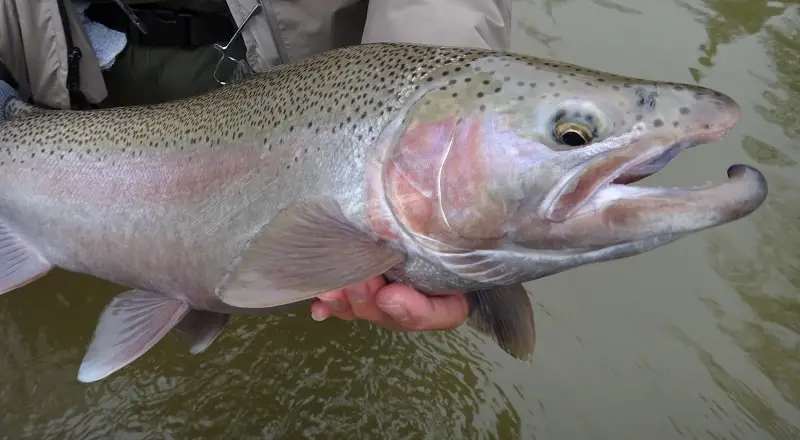
Steelhead are common in Alaska and can be found in the river almost year-round.
September, October, and November are good months to fish Steelhead using flies. But anglers will also have success in the spring.
Fly fishing for steelhead is probably the most popular method for catching them and it’s very effective. Just make sure you use the correct fly fishing methods and the best steelhead flies to use.
Depending on where you are, the weather will be much colder, and you will likely need special winter gear and methods to deal with the cold. Click the link to learn guide tactics and the gear they use to help them and their clients stay warm, dry, and comfortable even in the coldest weather.
What Fly Fishing Species Are There In Alaska?
There is a long list of fish species that are amazing for fly fishing. Those include:
- Salmon – Kings, Silvers, Reds, Chum, and Pinks
- Trout – rainbow trout, lake trout, Cutthroat trout, Sea Trout, etc.
- Char – Arctic Char and Dolly Varden Char
- Arctic Grayling
- Northern Pike
- Sheefish
- Pacific Halibut
- Sea bass
Keep in mind that you toss flies for big fish in freshwater or saltwater, and saltwater fishing is becoming quite popular.
Trout Fly Fishing In Alaska
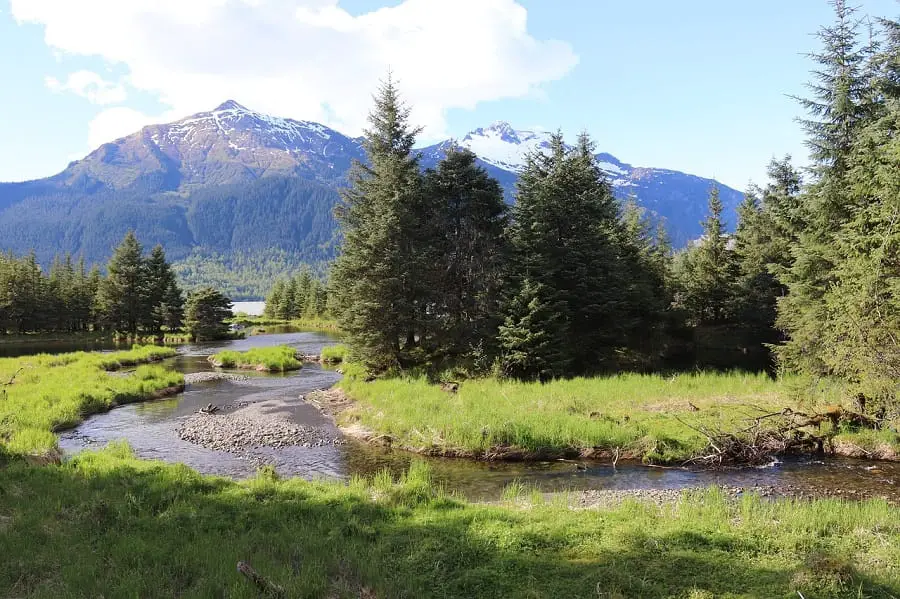
The mother of all trout in Alaska is the Rainbow Trout. A trophy rainbow can reach as long as 30 inches and fight you like a silver salmon.
The best area for big rainbows is along the Kenai Peninsula in rivers such as:
- The Kenai River,
- Copper River,
- Goodnews River,
- Russian River,
- Kasilof River,
- Naknek River
These are some of the best rainbow trout streams in Alaska, and often, the best fishing takes place further up the river in the headwaters area.
You can also target rainbows in areas, such as the Kenai wilderness, around Lake Iliamna, and within the Katmai National Park.
The Salmon Cycle
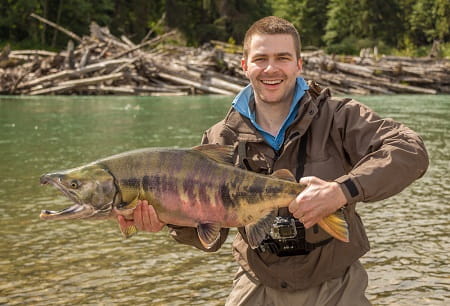
Trout and Char follow the salmon and feed on the roe during the spawning season.
The best times to target big trophy fishing are during the king salmon run and silver salmon runs.
In late July, you can target Char when the Silver Salmon run begins. In mid-June, big rainbow trout fishing gets hectic.
During this time, the King Salmon season closes, and the rainbows are thick in the spawning beds of the kings eating spent roe.
Ocean And Lake Fishing
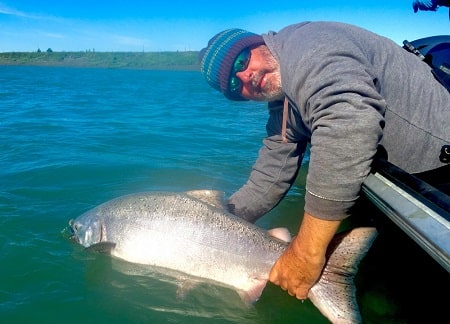
Fly Fishing in Alaska can also mean fishing in the inland lakes, out in the ocean or harbors, and at the river mouths.
Anglers can shorefish or fish from boats.
At times, the salmon, steelhead, and trout will be high enough in the water column to attach a well-presented streamer fly.
Angles can use sinking lines or floating lines if the fish are near the surface. It’s not uncommon to see fish rolling on the surface.
Targeting lake trout is also an option for fly anglers. The warmer months are the best as the lake trout are closer to the surface or in the shallows.
A trophy lake trout is in the 15-20 pound range, with the Alaska record for lake trout being 47 pounds.
Kenai Lake and Skilak Lake on the peninsula are good places to target lake trout. In the south, you can hit Susitna Lake.
One of the key things about fishing lake trout is that you can fish them year-round. Lake trout make a big target for ice fishing and a side hustle species for fly-out fishing when you limit out on silver salmon or kings.
Brook Trout, Cutthroat Trout, and Sea Run Dolly Varden
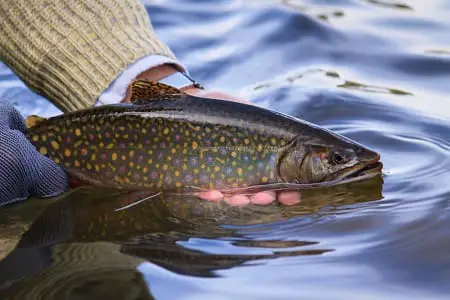
Brook Trout and Cutthroat Trout in the Southeast are popular species when fly fishing Alaska.
Look for lakes that have a drainage system, which is where you will find both.
Around coastal areas in the Southeast, cutthroats can be found in saltwater, making those areas a haven for fly fishing.
Salmon Fly Fishing In Alaska
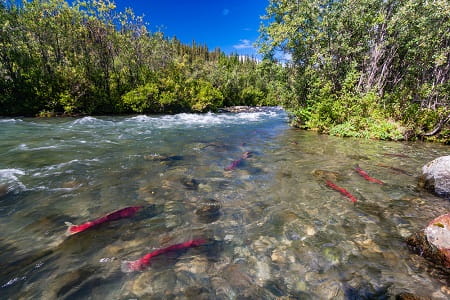
You’ve got choices when it comes to fly fishing for salmon in Alaska.
The first choice is whether you want to fish in the ocean or freshwater. Both can be very exciting.
For river fishing, the salmon migration is staged over the summer from May through September and sometimes into October.
There are five species of Pacific Salmon – King, silver, red, chum, and pink. All are available, and their run times are staggered.
That means that the best salmon fishing season will change based on where you fish and the type of salmon you want to target.
Even if you want to fish for kings, the run times for each river will also change. The Alaska wilderness is vast, and knowing when and where you will fish will help you find the best times to fish for salmon.
If you are going to be booking into a lodge, they will help you determine the peak times for each species of salmon.
For an overview and more info, check out Salmon Fishing In Alaska.
Best Location for Targeting Salmon
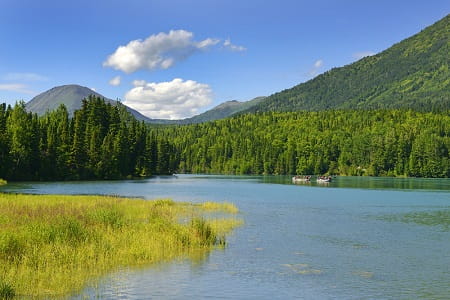
Saltwater salmon trips, rivermouth fishing, and inlets can be broken down into three general areas.
All of these areas will have salmon and steelhead passing through and will be good at times.
- Cook Inlet – which includes Homer and the mouth of the Kenai River, the entrance to Katmai National Wildlife Park, and Kodiak Island.
- Southeastern Alaska – which includes the inside passage and the outer fishing locations along the islands located there.
- The Gulf of Alaska – Includes Seward, the southern edge of the Alaska Peninsula, as well as great fishing in the open waters of the Gulf.
Remote locations can be reached by flyouts trips which also have the advantage of very few people. Some flyout trips will drop you off, then you drift down the river in inflatable boats and fish in remote spots other anglers can’t get to.
Some areas are accessible by jet boats, which makes it easier to cross large bodies of water and bigger rivers.
You can also book a fishing lodge that is right on the river you want. Fly-in lodges will take you away from the crowds and put you into some of the best fly waters in Alaska.
Flies For Fly Fishing In Alaska
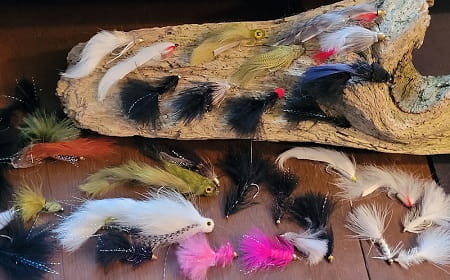
If you are not heading out with a guide and are bringing your own flies, you want to make sure that you have a variety of fly patterns.
During the summer, egg patterns are key as trout and salmon will strike at eggs more often than not.
Roe, which is also known as fish eggs or spawn, can change color the longer it is in the water. The fish eggs that are free-floating will age quickly, and they will lighten to almost pure white color.
Therefore, you want to be able to match the colors of the natural eggs, and this means you should bring a variety of colors, from dark orange, pink, and chartreuse to lighter colors like peach and white.
Cooper Landing Fishing Guide says that the Flesh Fly is one of the most effective flies for rainbow trout. Nymph patterns like the Pheasant Tail Nymph are also one of their good flies for all river species of trout and salmon.
Streamers are also a good option whether you swing them in, strip them in, or dead drift them when nymphing.
See: Nymphing For Salmon, and Streamer Fishing For Salmon.
Pike Fly Fishing In Alaska
Pike can be caught on the fly. In fact, anglers will travel very far for a chance to catch large pike on large streamer flies. Local guides will get you into the shallows, where you can sight fish for three and four-foot-long pike.
The record for pike in Alaska is 38 pounds 8 ounces.
The season generally begins in early April and runs through the end of October.
The peak fishing time is June and July, though you can target big trophy pike anytime during the season.
The best places to find big pike include:
- Nancy Lake – is 67 miles North of Anchorage just off Highway 3. Easy access for road fishermen, or you can book guides.
- Peterson Lake – Kenai Peninsula – Excellent for Ice Fishing
- Salcha River – 33 Miles North of Fairbanks – An easy drive for day fishers flying into Anchorage
- Prospect Creek – is in the far North 180 miles from Fairbanks.
Fishing for pike is a lot about dry flies over weed beds. Big pike lurk, and they eat almost everything that moves.
A rodent pattern fly – mouse, rat, shrew, etc., tossed over a weed patch and retrieved in a struggle pattern will entice a big pike to strike. Bring stainless steel leaders when you fish for pike, as their mouth will make short work of fishing line.
Lake Fly Fishing In Alaska
Lakes are awesome for trout, pike, char, and grayling. You can sometimes target salmon, but the best salmon fishing will likely be in a river.
Grayling – Usually above Fairbanks and into the northern stretches – look for lakes that have an inflow or overflow or both. You will often find grayling in those areas. Grayling is a smaller fish – a big one is in the three-pound range – but they are good to eat and fun to fish. Start with a dry fly such as an elk hair caddis or black gnat and then experiment with sinking flies.
Lake Trout – these can be heavy fish in the 20-40 pound range. They are often deep in the water, so a longer leader is necessary. Fly choices include the Clouser Minnow and similar flies. Some of the best lakes to fish for lake trout are accessible only by float plane. A lakefront fishing lodge can also be one of the best ways to access remote lakes.
Char – Arctic and Dolly Vardon – Char are fun to fish and they are aggressive. If you had one fly to fish for char, according to some local guides, it would be a Dolly Llama pattern, and probably in salmon tones.
One of the best places to fish for char is in the Brooks Range where you can hit the smaller lakes and rivers.
Best Fly Fishing Rivers in Alaska
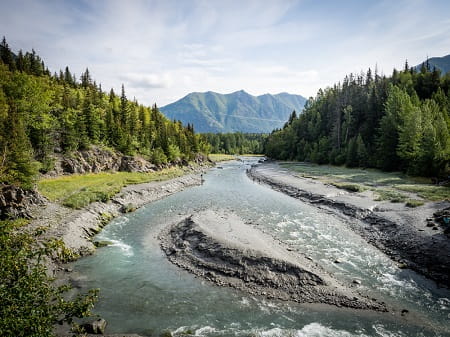
There are a lot of pristine and wonderful rivers in Alaska on which you can toss flies for big fish. Some rivers are huge and you will need a boat, others are perfect for walk and wade trips.
The smaller river or the upper sections of the biggest river will concentrate the fish and make it a little easier to catch them.
Some of the best include:
- The Kenai River
- Russian River
- Kasilof River
- Copper River
- Naknek River
- Alagnek River
- Yukon River
- Etc.
Because the run times vary from one river to the next, you can often find the season closed on one river but not on another.
The best river to fly fish is the one that is open for fishing and primed with run times for the fish you want to target. If you are staying at a fishing lodge, you can check with them about access to local rivers and fishing guides.
You will also find fly-fishing lodges on many rivers, and access to some of the most remote and wild rivers will be through a fly-out lodge or float plane.
Bears and Scenery In Alaska
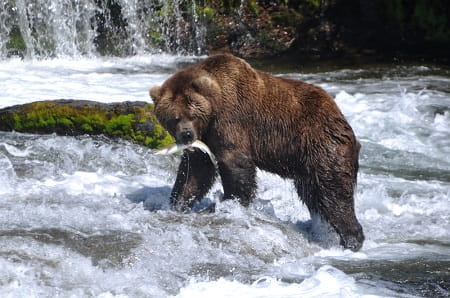
Bears and beautiful scenery are among the greatest aspects of visiting and fly fishing in Alaska.
The most famous place to view bears fishing is Katmai National Park and Preserve, where they have bear viewing stations so you can safely watch the bears in their natural habitat.
During Salmon season, you will find bears on every river where the salmon are swimming. The best place to view bears is often from a float plane or helicopter.
Alaska is full of beauty. You can visit glaciers, fly over the caldera, view volcanos, visit national parks that are insanely beautiful, and take guided tours of natural wonders such as the Valley of 10,000 Smokes. See Safety Tips For Fishing Near Bears.
Best Alaska Fly Fishing Trips
You will get the most out of fishing trips in Alaska when you use guides. If you are staying at a river lodge, chances are they have their own guides. Regardless, book your guided fishing trip in advance, as they will disappear quickly as the fishing season approaches. Many Alaska fly guides are booked out over a year in advance.
Some of the best fishing trips in Alaska include:
- Guided float down the Kenai River – especially the upper and middle Kenai
- The fish camps on the NakNec – amazing access to kings and big rainbow trout. Most are rugged but comfortable, and they offer the best service.
- A float trip down the Copper River – target big Rainbows and Salmon – often a day trip with a fly-out guide.
- Katmai Lodge – guided fishing and bear viewing.
- Fishing tour of the Kenai Peninsula – Seward, Cooper Landing, Homer, Kenai, Soldotna, and other cities along this beautiful and prolific fishery
Best Alaskan Fly Fishing Lodges
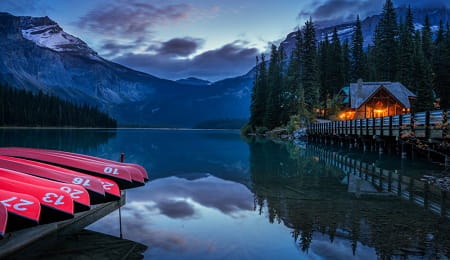
An Alaskan fishing lodge varies from one side of the stream to the other.
You will find exclusive lodges with a long history of top-notch service and full amenities and 100 percent DIY lodges with a stack of bunk beds and a small kitchen.
The best places are those with vacancies, as many fishing lodges will book far in advance. Even a small lodge in a remote setting will fill up quickly. A fly-out lodge will likely be more expensive but may also offer the best fishing for that area.
Things to consider when booking a fishing lodge
- The location from Anchorage – Most commercial airlines fly only into Anchorage and then you have to make your way to the lodge. That can mean driving or booking an air taxi or even taking a ferry.
- For the fly-out lodge – do they pilot their aircraft or do they recommend a bush plane company? Also, will they help you set up transportation to the lodge? A river lodge may fly you in or offer a jet boat.
- Number of Guests – A river lodge that holds a lot of anglers means you are going to vie for resources, fishing locations, guides, and services. A lodge with a smaller number of guests will often provide more personalized service and care about your experience.
- Private cabins – It is important to know what is included in a private cabin. Some will require that you bring your bedding, towels, etc. Costs may also add up for extra services like internet, television (if available,) and other amenities.
- Access to Groceries or Food – if meals are not provided by your river lodge, then you will need access to food. Where is the nearest grocery store, and are there local restaurants close by?
- Privacy – Some lodges cram you into small rooms in the main lodge while others may offer a small cabin or a small villa next to the lodge. Most river lodges have a mixture of both – in-lodge and cabins.
- Services and Amenities – There is a range of services and amenities that even the smallest river lodge will offer. Sometimes five-star service is not available because the site is too remote. Most of the time the lodge makes up for that by keeping you busy fishing, providing excellent food, and as much comfort as possible. It is important to pick a lodge based on your expectations. In other cases, you will have to make do with what is available if you want to fish in a specific location. A good tip is to book early and check availability often.
- The Type of Fishing Offered – Guides, Self-guiding, and DIY are all options. If you are fishing from a boat – drifting – how long is the fishing day? If you are expected to hike into a fishing location, then ask if the river is easily waded. Hiking adventures are easier on anglers without limited mobility.
Do It Yourself Fly Fishing In Alaska
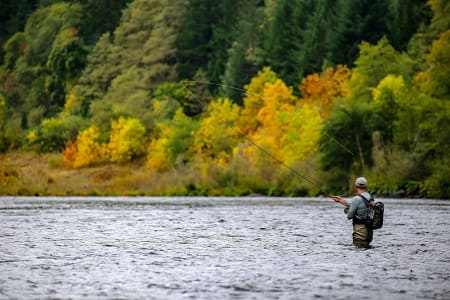
You can DIY fish in Alaska. You will need to understand where you can fish and where fishing is not permitted.
There are a lot of national and state parks, refuges, and other park-like lands where you cannot fish.
Many rivers have access from the highway but expect those places to be busy with locals and tourists fishing too.
The bear danger is always a concern when fishing in Alaska and is one of the biggest reasons not to DIY fish. A guide will help to keep you safe and be an extra resource if you get into trouble, have an emergency, or are attacked by a bear or moose.
Alaska Fly Fishing Guides
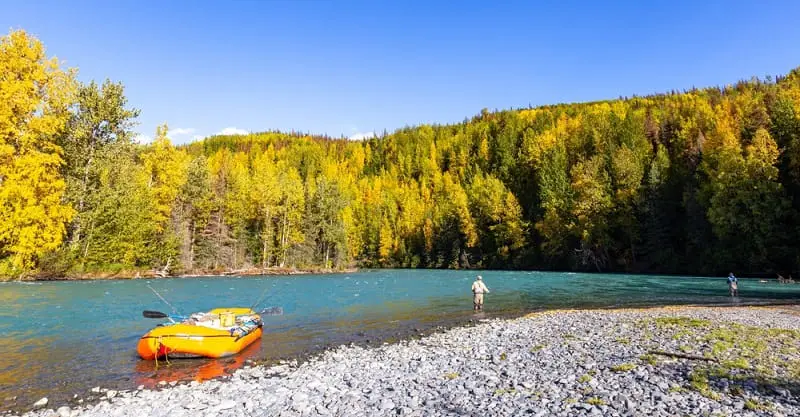
Perhaps the best way to experience fishing of any kind in Alaska is to use a guide. The advantages are that they know the local area and will help you adjust to fishing in the Alaskan wilderness.
Some will also have special permits that allow you to fish in rivers and streams where other anglers are not permitted. Plus, most guides have a boat and all the fishing gear you need.
Some fishing lodges in Alaska will supply their own guides as part of your experience there. Others may recommend guides and some will allow you to either guide yourself or find a local guide.
There are bears in the area so know what to look for and how to protect yourself near bears.
You might also see Dip net fishing for salmon which is common among Alaska residents.
Tight Lines,
Graham
